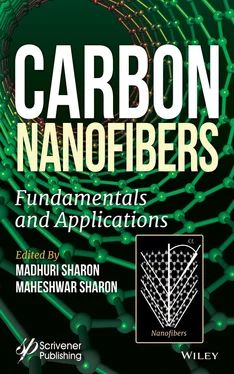1 Cover
2 Title Page
3 Copyright
4 Dedication
5 Foreword
6 Preface
7 1 An Introduction to Carbon Nanofiber 1.1 Introduction 1.2 Properties of Carbon Nanofiber and How It Differs from Carbon Nanotube 1.3 Synthesis of Carbon Nanofiber (CNF) 1.4 Properties of CNF and Its Composites 1.5 Applications of CNF 1.6 Health Hazards of CNF 1.7 Summary References
8 2 Biogenic Carbon Nanofibers 2.1 Introduction 2.2 Plants as Source of Precursor for CNF Synthesis 2.3 CNF Derived from Parts of Different Plants and Their Applications 2.4 Comparative Structure of Chemically and Biogenically Synthesized CNF 2.5 Concluding Remarks References
9 3 Role of Nanocatalysts in Synthesis of Carbon Nanofiber 3.1 Introduction 3.2 Nanocatalysts 3.3 Methods for the Preparation of Nanoparticles 3.4 Role of Nanocatalyst in the Production of CNF 3.5 Different Types of CNF 3.6 Synthesis of Carbon Nanofiber (CNF) Using Nanocatalysts 3.7 Summary References
10 4 Carbon Nanofiber and Polymer Conjugate 4.1 Introduction 4.2 What Is a Composite? 4.3 Polymers Used for Conjugating CNF 4.4 Approaches Involved in Synthesizing Polymer/ CNF Nanocomposites 4.5 Various CNF Composites 4.6 Possible Futuristic Applications of CNF/Polymer Composites 4.7 Summary References
11 5 Characterization of Carbon Nanofiber 5.1 Introduction 5.2 Microscopic Characterization Techniques 5.3 Spectroscopic Characterization 5.4 Spectroscopic Analysis of CNF by XRD 5.5 Measurement of Mechanical Properties of CNF 5.6 Optical Property Analysis of CNF 5.7 Thermal Properties and Thermal Effect Analysis 5.8 Specific Surface Area (SSA) Determination of CNF 5.9 Characterization of Electrical Properties References
12 6 Carbon Nanofiber – A Potential Superconductor 6.1 Introduction 6.2 Superconductors 6.3 History of Existing Superconductors 6.4 Superconductivity in Organic Materials 6.5 Can Carbon Nanofiber Also Be a Possible Superconductor? 6.6 Summary References
13 7 Carbon Nanofiber for Hydrogen Storage 7.1 Introduction 7.2 Hydrogen – Its Advantages and Disadvantages as Source of Energy 7.3 Methods of Hydrogen Storage 7.4 Different Forms of Carbon and Nanocarbon for Storage of Hydrogen 7.5 Carbon Fibers for Storage of Hydrogen 7.6 Pyrolyzed Natural Fibers from Plant/Animals to Store Hydrogen 7.7 Summary References
14 8 Carbon Nanofiber for Microwave Absorption 8.1 The Need to Develop a Microwave Absorber 8.2 Types of Microwave Absorbers 8.3 Considerations for Nano Absorbers 8.4 The Radars 8.5 Role of CNF in Microwave Absorption 8.6 Need for Fabricating a CNF and Polymer Composite 8.7 Summary References
15 9 Carbon Nanofiber for Removal of Dye from Aqueous Medium 9.1 Introduction 9.2 Morphology of Biogenic and Chemically Synthesized CNFs from Different Precursors 9.3 Novel Dye Removal Properties of CNF 9.4 Absorption of Different Dyes 9.5 Summary References
16 10 Carbon Nanofiber to Remove Heavy Metals from Aqueous Medium 10.1 Introduction 10.2 Are Heavy Metals Essential for Living Beings? 10.3 Methods Used for Removal of Heavy Metals 10.4 Evaluation of Heavy Metals Removal Processes 10.5 Role of CNF in Removing Heavy Metals 10.6 CNF to Remove Heavy Metals 10.7 Summary References
17 11 Carbon Nanofiber as Electrode in Li-Ion Battery 11.1 Introduction 11.2 Types of Lithium-Ion Batteries 11.3 Theory of Generation of Power in Lithium Battery 11.4 Role of Carbon, Lithium and Cobalt in Li-Battery 11.5 Role of CNF in Lithium Battery and Possibility of Increasing Its Efficiency 11.6 Recent Advances in Lithium Battery Utilizing Carbon Nanomaterial and CNF 11.7 Summary References
18 12 Carbon Nanofiber and Photovoltaic Solar Cell 12.1 Introduction 12.2 Formation of a Semiconducting Material 12.3 Semiconductors for Solar Cell 12.4 Attempts Made in Making Carbon-Based Solar Cell 12.5 Is CNF a Suitable Material for Solar Cell? 12.6 Summary References
19 13 Application of Carbon Nanofiber in Antenna 13.1 Introduction 13.2 Radiation Types and Characteristics of Antenna 13.3 Carbon Nanomaterial 13.4 Application of Carbon Nanofibers in Antenna 13.5 Summary References
20 14 Carbon Nanofiber in Cosmetics 14.1 Introduction 14.2 What Is a Nanocosmetic 14.3 Cosmetics with Nanoparticles in Today’s Market 14.4 Nanoparticles Used in Cosmetics 14.5 Nano-Compositions Used for Loading and Delivery of Nanoparticle 14.6 Cosmetics Containing Carbon Nanomaterials 14.7 Can Activated Carbon, Carbon Black and Carbon Nanotubes Be Replaced with CNF for Use in Cosmetics? 14.8 Summary References
21 15 Carbon Nanofiber in Regenerative Medicine 15.1 Introduction 15.2 Cell Tracking and Labeling 15.3 Sensing Cellular Behavior 15.4 Augmenting Cellular Behavior 15.5 Carbon Nanotubes as Structural Support for Tissue Engineering 15.6 Cytotoxicity of Carbon Nanofiber (CNF) 15.7 Biocompatibility of Carbon Nanofibers 15.8 Dispersion of Carbon Nanofibers 15.9 Summary References
22 16 Carbon Nanofibers and Agro-Technology 16.1 Introduction 16.2 Carbon Nanofibers 16.3 Carbon Nanofiber and Agriculture 16.4 Summary References
23 Index
24 Also of Interest
25 End User License Agreement
1 Chapter 2 Table 2.1 Surface area of CNF synthesized from different parts of maize plant an...
2 Chapter 4 Table 4.1 Properties of different nanocomposites.
3 Chapter 5Table 5.1 XRD results for PAN-based carbon nanofibers.Table 5.2. XRD results for PAN-based carbon nanofibers.Table 5.3 The specific surface area of NiMo/CNF with various synthesis temperatu...
4 Chapter 6Table 6.1 Critical temperature (Tc) of some known superconductor element [5].Table 6.2 Some known superconducting compounds with critical temperatures. (Sour...Table 6.3 Organic superconductors with their critical temperatures. (Source: htt...
5 Chapter 7Table 7.1 Tap density of CNF (synthesized from cotton using different metals for...
6 Chapter 10Table 10.1 Heavy metal adsorption capacities of modified natural materials.Table 10.2 Heavy metal adsorption capacity of some agricultural and biological w...Table 10.3 Heavy metals adsorption capacity of modified biopolymers. (Source: Cr...Table 10.4 Advantages and disadvantages of the various physicochemical methods f...Table 10.5 Comparative data (Yield, Morphology, Diameter, Surface area) of diffe...
7 Chapter 12Table 12.1 Abbreviated periodic table of the elements.Table 12.2 Energy gap (eV) of some materials used for photovoltaic cells.Table 12.3 Properties of carbon allotropes [21].Table 12.4 Performance of various carbon-based photovoltaic cells.
8 Chapter 14Table 14.1 Cosmetics incorporating carbon-based products.
1 Chapter 1 Figure 1.1 The formation angle between the carbon for sp, sp 2and sp 3configurat... Figure 1.2 SEM image of carbon fiber. Figure 1.3 (X) A sheet of graphite showing free edges A, which are reactive and ... Figure 1.4 SEM images of carbon fibers (CF) synthesized from camphor as precurso... Figure 1.5 Schematic illustration of (a) how single layer of graphene folds to m... Figure 1.6 (a) TEM image showing graphene layers of (b) entwined carbon nanofibe... Figure 1.7 Schematic illustration showing (a) the formation of bonds of carbon a... Figure 1.8 A sketch of a typical CVD unit. A1 and A2 are two furnaces operating ... Figure 1.9 (a) typical sketch of CVD unit with a spray system and (b) the aligne...
2 Chapter 2 Figure 2.1 Schematic diagram of Tracheid, Tracheae and Xylem fiber. Figure 2.2 Schematic diagram of Sclerenchymatous fiber (left) in L.S. view and r... Figure 2.3 Schematic diagram of Phloem fiber. Figure 2.4 (a) Maize fiber and (b) maize fiber after pyrolysis as CNF. Figure 2.5 Characterization of CNF obtained by pyrolysis of plant stems (Courtes... Figure 2.6 XRD of CNF showing (002) plane of graphite (Hsieh et al ., 2003). Figure 2.7 (a) Raman spectra of amorphous carbon film showing an overlapping wit... Figure 2.8 Characterization of CNF obtained by pyrolysis of plants seeds (Courte... Figure 2.9 Characterization of CNF obtained by pyrolysis of plant oils (Courtesy... Figure 2.10 CNF synthesized from oil of Linum usitatissimum by CVD method. Figure 2.11 CNF synthesized from seeds of Jackfruit and Rice straw by CVD method... Figure 2.12 CNF synthesized from chemical precursors: (a) Ethanol and (b) Acetyl... Figure 2.13 Schematic illustration of CNF and CNT.
Читать дальше


![Carbon - Посох с проблемами [калибрятина, куски]](/books/397599/carbon-posoh-s-problemami-kalibryatina-kuski-thumb.webp)

![Carbon - Ключ от магии, или Нимфа по вызову [СИ]](/books/417919/carbon-klyuch-ot-magii-ili-nimfa-po-vyzovu-si-thumb.webp)
![Carbon - Девушка с Косой [СИ]](/books/427728/carbon-devushka-s-kosoj-si-thumb.webp)






